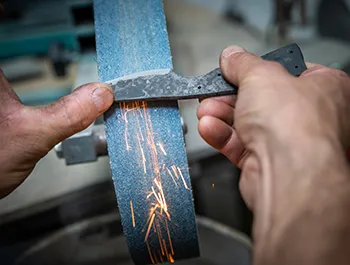
Many of us do not know about the importance of reprofiling a knife. If you see, in numerous commercial premises sharpened knives play a great role. Furthermore, we need a reprofiled knife in our daily life too. But the fact is, everybody has not yet acquired the perfect steps on how to reprofile a knife.
Don’t worry. This article is going to help you with all your confusion. Here, I have accumulated some genuine steps that you can follow to reprofile your blunt knife. Nonetheless, some grit stones are a must to have while reprofilling your. But it doesn’t end here. You should also know about the grit numbers and way of stroking, and so on.
All being well, this article will also tell you how to reprofile a knife tip as well. Let us not beat around a bush anymore and go through the steps straight.
How to reprofile a knife blade
Since there are numerous techniques of maintaining knife blades, we can’t still associate them with the right one. For this reason, here I will describe the best way to reprofile a knife blade.
Step 1: Gather some grit stones
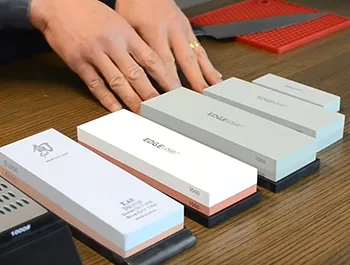
First of all, take a dull knife and spend quite a bit of time on the edge Pro. Just take a low grit stone and try to bring the edge back. Then draw them with some sharpie on both sides. Afterwards, make your whole spot colored by putting on a grinding wheel.
When you are done, take off the majority of your knife’s metal on a grinding wheel. Then finish refining and cutting a new bevel on a belt sander. And then take a file for the edge row which will make the edge consistent along the whole length.
Step 2: Work with the edge Pro stones

Next jump in with your edge Pro stones and finish the knife. So now your edge is drawn, the next step is to remove the majority of your material with a bench grinder. For now, replace your coarse wheel with a wire brush. And if you see, your wire brush will get a lot of use, especially with the yard tools and other stuff that come in. Moreover, some high carbon knives get the rust off pretty quick.
Well, a bench grinder is kind of risky to use because if you heat up the steel too much, it may change the temper of the steel and effectively ruin the steel. So that is why you need to go real slow and a low-pressure will pass.
Step 3: Take the knife’s metal off
Anyway, take your knife’s metal off slowly so that the hot metal does not touch you. At the same time, cut a bevel to center your knife’s edge between either face of the blade. Now, take off material on any side to keep your knife’s edge in the center.
Make sure each bevel is the same size. Then take your restored tip to the belt sander and just take a couple passes down. As a result, you can cut the fresh bevel effortlessly.
Step 4: Use stones on the back of edge
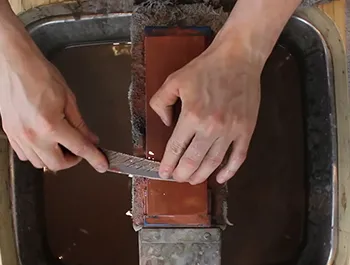
However, you can’t go heating up your steel. Otherwise, you are gonna ruin it. For now, reprofile your blade at 21 degrees and be ready with a burr and a couple of nicks. Using these alternatives, you have to work on your edge back and get your nicks out.
Without a sander it would take a long time sawing away with a stone. Well, a sander, i.e. one inch by 30 inch belt made by grizzly can be a good object. On the other hand, a 240 grit belt can also make your task smoother.
Step 5: Swap your belt
A flat platen will allow you to set your knife up and have more control over the angle. Besides, it is opposed to cutting on a round wheel. For this reason, you are to swap your belt out to put on a dust collection.
Right now, you have got a bevel and the edge is the same as bevel. Well, I feel like a monstrosity would do a real nice job at reprofiling a machete. And by using stones, you can save a lot of time in reprofiling your knife.
Step 6: Pull some strokes
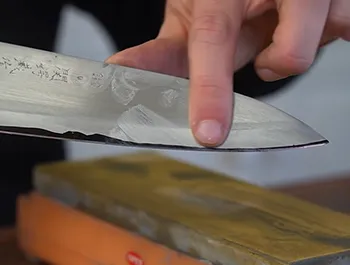
Then pull some strokes off the blade coming back your angle on the belt sander. Make the angle constant across the whole bevel. And remember not to work the tip too much on your belt sander as it can heat up a lot.
So this will be a nice way to get that edge right at the tip. Still, you will need a little work to make a pass down.
In your file card, you will see one side is a little wire brush and that is for heavier coarser files. On the flipping side, there will be some stiff nylon bristles which don’t get gummed up easily. Now, you have to cut a chamfer on each side of files to make them fit nicely in the edge Pro.
Step 7: Make an ultimate sharpness
Nonetheless, you can just put your knife back on a bench grinder and read the chamfer. Well, a burr built and its building on both sides can be helpful to build it in one pass with the stone.
After you have brought the edge back on a belt sander, step through your diamond matrix tones from edge Pro. Next, finish working on your knife using an eleven hundred grit diamond matrix stone. Thus, your knife will become sharper than it has ever been.
How much does it cost to reprofile a knife?
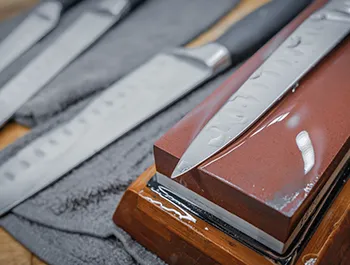
The cost to reprofile a knife is not the same all the time. Again, reprofiling a knife’s price varies from place to place. However, the reasonable price you will get to see is from $1.50 to $2.25 on every inch of a knife’s length.
Also, how much damage or dull your knife is, will determine the price of its reprofile.
Frequently Asked Questions
1. What does it mean to Reprofile a knife?
To reprofile a knife actually means to enhance the characteristics performance of a knife. Whenever you will be reprofiling a knife, you will need to change your knife’s bevels. Not only that, you shall also change the angle of bevels precisely in order to get a perfect reprofile.
2. How long does it take to Reprofile a knife?
Well, how much time you will need to reprofile a knife depends on the coarseness of your stone. Suppose, the factory grind of your knife is about 25 degrees and you want to reprofile it to 15 degrees. At that time you may require 30 to 60 minutes.
Along with the coarseness, the amount of pressure you will be putting, matters during reprofiling your knife.
3. Can you change the angle of a knife?
Yes, it is possible to change the angle of a knife. For instance, changing the angle of a knife from 20 degrees to 15 degrees will require more precise sharpening. So if you want to change your Kinfe’s angle, be certain of its sharpening condition.
4. Can you repair a broken knife?
No doubt, a broken knife can be sharpened with a knife sharpener. But here, you will need a sharpener, i.e. of a coarse abrasive knife. As there is a coarse diamond plate, you will not find any disturbance while repairing your broken knife.
And if you want, you can also reshape your knife with some power tools in accordance with extreme caution.
Conclusion
Till now, we have gathered ample knowledge about enhancing our knives. Before that, the guide on how to reprofile a knife deserves your eye’s first catch. Hopefully you do not have any more confusion now by reading the above article.
Overall, the guide will first tell you to be ready with some grit stones, edge Pro stones, etc. Therefore, you will not face any trouble while reprofiling your knife.
We know, sharp knives are not only used in commercial premises, but also in our daily activities too. So, to make sure none of your operation goes bland, try out the steps quickly and make your knife more solid than ever.
Up Next : How To Sharpen A Stainless Steel Knife And Why It’s Important?
